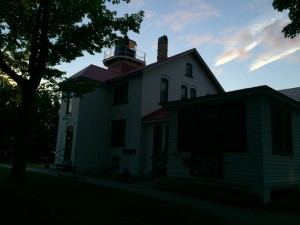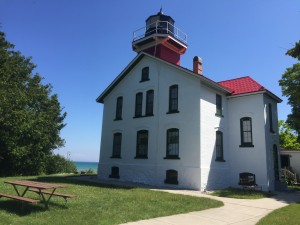Before the United States Coast Guard
Before the creation of the modern day U.S. Coast Guard, there were four small organizations that helped to aid in the assistance and safety of mariners. One of the first of these organizations was the U.S. Lighthouse Service. As shipping across the Great Lakes increased, the demand for aid in navigation along these lakes grew. This particular service was in charge of maintaining lighthouses and sea markers so that mariners would be warned of the eminent danger. They were even many reports of many lighthouse keepers themselves saving the lives of mariners. The U.S. Revenue Cutter Service also was in charge of assisting mariners in distress, especially during their winter cruising rescues. The Steamboat Inspection Service was established to prevent any possible problems that could occur [2]. Yet the organization that gave the U.S. Coast Guard the image as a lifesaver was the U.S. Life-Saving Service, which was responsible for many search and rescue expeditions [1].
In 1789 there were 12 lighthouses established in the United States and by 1866, 60 more were aiding in ships safety. From the keepers’ point of view, the lighthouses were lonely and their tasks of keeping the station and its equipment clean were monotonous and mundane [2]. One of the main tasks of a lighthouse keeper is to continually make sure the lamp, the main source of light before electricity, was trimmed and kept burning. There were many accounts of lighthouse keepers and their stories of their time as civilian keepers
Grand Traverse Lighthouse

One of the many lighthouses that was built along these Great Lakes was the Grand Traverse Lighthouse. The Grand Traverse Lighthouse is located at the tip of the Leelanau peninsula in Northport, Michigan. Often it was referred to as the Cat’s Head Bay Lighthouse, Lighthouse Point, and Northport Light. Located between Lake Michigan and Grand Traverse Bay, it marks the Manitou passage, and has been guiding sailors and their vessels safely through these waters for 164 years [5].
The construction of the original lighthouse was commissioned in 1850 and the lighthouse was completed in 1852. The lighthouse, typical of the time, was built low and close to the water. It consisted of a squat rubble stone tower and a detached lighthouse keepers quarters. As the threat of the lighthouse tower falling into water and the erosion of the foundation became more eminent, the lighthouse was demolished [7]. In 1858, a new light station was erected by the U.S. Lighthouse Service on higher ground. This provided a more substantial structure and higher visibility, with a range of 12 miles, to passing ships. Then in 1899, a fog signal was added to add in guiding ships through the Manitou passage [6]. Due to the increased amount of work the lighthouse keeper had running the lighthouse and now the fog signal, a second keeper was needed and the lighthouse building was expanded to a two-family dwelling in 1900.

In 1939, the U.S. Coast Guard took over the management of the Lighthouse Administration from the U.S. Lighthouse Service. As a result of this, the lighthouse personal were given a choice to either join the Coast Guard or become civilian keepers [8]. The Coast Guard stationed keepers at the lighthouse until the building was closed in 1972 and an automatic light located on a steel tower was erected [4]. In 1987, the lighthouse was reopened to the public and can now be toured. Run by the Grand Traverse Lighthouse Foundation, the lighthouse still houses keepers to maintain the grounds and museum. Exhibits in the lighthouse and fog signal building include the great lakes lighthouses, foghorns, and shipwreck, local and coast guard history [5]. The Coast Guard had a rich influence on not only the lighthouse but the area and town of Northport as well.
U.S. Lighthouse Service
Aside from the U.S. Lighthouse Services duty in keeping the many lighthouses running, they took up many other operations to keep the waters of the United States, including the Great Lakes safe. One of these was in areas where lighthouses were unable to be built, the U.S. Lighthouse Service created lightships to continue to provide safety to ships in thick weather. This was an isolated and dangerous duty, especially due to the fact that the vessel must remain on station no matter the conditions, or the possibility of being unseen and rammed by another ship. The first lightships on the great lakes were stationed in 1891 on Simmons Reef, White Shoal and Gray’s Reef on Lake Michigan [2]. The duties on these ships were similar to that of regular lighthouse keepers and were reported to be lonely and monotonous, with the addition of being dangerous as well.
Another creation that the U.S. Lighthouse Service operated were Lighthouse Tenders. Their duty as tenders was stated as “vessels whose duty it is to go where no other vessels are allowed to go, and who, through storm, darkness and sunshine, do their work…” Commissioned by the Lighthouse Service, the first tenders on the lakes, such as the Dahlia in 1874, were especially made to endure light ice and created the custom of naming these tenders after herbaceous species.
U.S. Revenue Cutter Service
The next organization that led to the creation of the U.S. Coast Guard was the U.S. Revenue Cutter Service. This service was in charge of stopping sea smugglers and loss of revenue that this entailed. Yet their duty on the Great Lakes was different than on the oceans. On the Great Lakes, cutters such as the Mackinac were assigned “for customs duty, and to enforce the rules and regulations governing the movements and anchorages of vessels in the St. Mary’s River” [2]. They then became known as the St. Mary’s River Patrol.
U.S. Life Saving Service
The next predecessor organization that was especially key to the life-saving reputation was the U.S. Life-Saving Service. They began as a volunteer organization with a mission to rescue shipwrecked mariners that were close to shore. When Congress realized how important and essential this service was they authorized more funds for stations to aid in their future lifesaving operations. For example, because of Congress, lifeboats to serve such points of Lake Michigan were provided and were generally established at light stations. By the end of 1854, there were 9 boats on Lake Ontario, 14 on Lake Erie, 23 on Lake Michigan and one on Lake Superior [1].
The service officially began in 1876, after much accusations of their poor performance due to many maritime related accidents and deaths. Many additional units were added to Lake Huron, Lake Ontario, and Lake Erie and were expanded to include Lake Superior and Lake Michigan. More stations began being built as shipping increased across the lakes and by 1914, there was 62 stations.
Steamboat Inspection Service
The last of the four agencies before the creation of the Coast Guard was the Steamboat Inspection Service. This organization was the least documented out of the four predecessors to the Coast Guard. It was created due to the introduction and growth of steam powered ships and the problems that developed along with them. Their duties were listed in 1911 and were to inspect vessel construction and equipment, examine and license marine officers, examine seamen and investigate marine casualties and violations of inspection laws, establish regulations to prevent collisions and establish regulations for the transporting of passengers and merchandise [2]. On the Great Lakes the Eighth district was in charge of all waters north and west of Lake Erie with its’ headquarter in Detroit, and the Ninth which included the St. Lawrence River, Lake Erie, Ontario and Champlain with its headquarters in Cleveland, Ohio.
Creation of the present day U.S. Coast Guard
Eventually in 1915 on the 15th of January, to merge government operations such as the U.S. Revenue Cutter Service and U.S. Life Saving Service, the U.S. Coast Guard was formed [2]. The U.S. Coast Guard incorporated the traditional duties of these two previous organizations before its creation, into their duties as well. In 1939 the U.S. Lighthouse Service was also added to the U.S. Coast Guard.
Today their missions include: ports, waterways, and coastal security, drug interdiction, aids to navigation, search and rescue, living marine resources, marine safety, defense readiness, migrant interdiction, marine environmental protection, ice operations, and other law enforcement (in order of percentage of operating costs) [3].
Map location
Primary sources
1. Dennis L. Noble. “A Legacy: The United States Live-Saving Service“. A Bicentennial Publication from the Coast Guard Historian.
2. Dennis L. Noble. “Great Lakes: a brief history of U.S. Coast Guard operations“. Coast Guard Bicentennial series.
3. “U.S. Coast Guard Great Lakes Maritime Strategy“. U.S. Coast Guard Ninth District.
Secondary sources
4. Andrew L. McFarlane. “The House Under Light.” The Northern Michigan Journal.
5. “Grand Traverse Lighthouse.” Grand Traverse Lighthouse RSS. N.p., n.d. Web.
6. “Grand Traverse Lighthouse.” LighthouseFriends. N.p., n.d. Web.
7. “Seeing The Light – Grand Traverse Lighthouse.” Seeing The Light – Grand Traverse Lighthouse. N.p., n.d. Web.
8. “Grand Traverse Lighthouse 1939-1972.” Excerpt received from Lighthouse Foundation.
9. “Grand Traverse Light Station Logbook.” National Archives, Washington D.C.
Further reading
